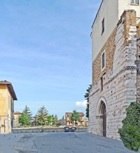
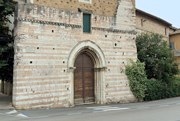
The church of San Claudio was documented in 1138, when Pope Innocent II confirmed it as a possession of Bishop Benedetto of Foligno. Two other relevant documents are described in Guerrini and Latini (referenced below, at p. 303, entry 81):
-
✴A prior of San Claudio was documented in 1188.
-
✴In 1212, Bishop Egidio gave the complex to the Crociferi and authorised the construction of a church, a bridge and a hospital. This probably referred to a rebuilding of an existing church and also an existing bridge. I think that this bridge was probably documented in the 10th century, when it crossed a branch of the Topino that lay between the later site of San Claudio and the Isola Bella. The remains of it were recently unearthed at the junction of what are now the Via di San Giovanni dell’ Acqua and the Via Isola Bella/ Via Giovanni Pascoli (i.e to the right of the complex). It probably subsequently became known as the Ponte di San Claudio.
According to Mario Sensi (referenced below, at p. 263), Pope Gregory IX gave the church and hospital on this site to a community of Poor Clares from Carpello, outside Foligno. In 1514, two sisters moved here from Santa Lucia in order to reform the community.
The nunnery was suppressed in 1862.

Vestiges of the side of the church and the cloister can be seen from the inner courtyard at number 40.
Art from the Church
The following are frescoes were detached from the church in 1868 and are now in the Pinacoteca Civica:
Frescoes from San Claudio (late 14th century)
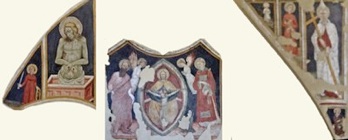
These detached frescoes include:
-
✴a Pietà, with St Catherine of Alexandria to the left;
-
✴a representation of the Trinity in a mandorla with SS Paul and Lawrence and two angels ; and
-
✴St Helen holding the True Cross, with smaller figures of SS Margaret and an unknown female saint to the left and the kneeling St Jerome below.
Fresco fragment (late 14th century)
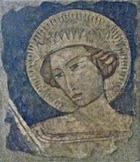
Madonna del Latte (early 15th century)
Way to Calvary (15th century)
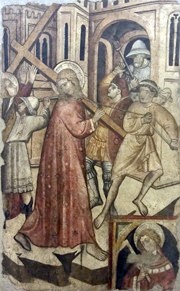
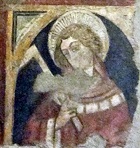
Detail (enlarged)
This detached fresco is also attributed to Giovanni di Corraduccio Mazzaforte. The Pinacoteca includes it among those from San Giovanni Decollato, but the presence of an image of St Claudius (with a set square) in the lower right-hand corner suggests (at least to me) that it came from San Claudio.
Scene from Life of St Benedict (15th century)
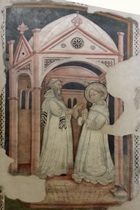
Pietà with saints (1543)
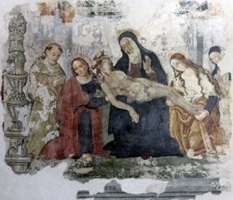
This dated fresco of the Pieta with the Virgin and SS Francis, John the Evangelist and Clare is from the nunnery.
Read more:
P. Guerrini and F. Latini, “Foligno: Dal Municipium Romano alla Civitas Medievale: Archeologia e Storia di una Città Umbra”, (2012) Spoleto
M. Sensi, “Storie di Bizzoche: tra Umbria e Marche”, (1995) Rome
Return to the page on Monuments of Foligno
Return to Walk II




